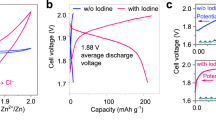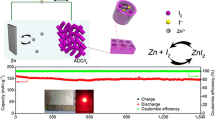Abstract
An aqueous rechargeable lithium ion battery with metallic cadmium as the negative electrode, LiCoO2 nanoparticles as the positive electrode, and a neutral aqueous electrolyte solution of 0.5 M Li2SO4 and 10 mM Cd(Ac)2 is reported. It has good electrochemical performance. The calculated energy density based on the practically available capacity of the two electrodes is 72 W h kg–1; this is comparable to that of Ni–Cd batteries. The positive mercury electrode of the Weston cell is replaced by a LiCoO2 electrode, the negative cadmium amalgam by a plain cadmium metal electrode. Mercury is completely avoided. Compared with Ni–Cd batteries an alkaline electrolyte solution is not needed making the system more environment-friendly.





Similar content being viewed by others
Notes
In the International Weston normal cell approx. 15 wt % cadmium in mercury and a cadmium sulphate-saturated electrolyte solution are used.
The anodic current is not limited by diffusion, thus there are only peaks with both setups limited by the cathodic electrode process.
REFERENCES
Wang, X.W., Wang, F.X., Wang, L., Li, M., Wang, Y., Chen, B., Zhu, Y., Fu, L., Zha, L., Zhang, L., Wu, Y.P., and Huang, W., An aqueous rechargeable Zn//Co3O4 battery with high energy density and good cycling behavior, Adv. Mater., 2016, vol. 28, p. 4904.
Choi, N.S., Chen, Z., Freunberger, S.A., Ji, X., Sun, Y.K., Amine, K., Yushin, G., Nazar, L.F., Cho, J., and Bruce, P.G., Challenges facing lithium batteries and electrical double-layer capacitors, Angew. Chem. Int. Ed., 2012, vol. 51, p. 9994.
Wang, X.W., Li, M.X., Wang, Y.F., Chen, B.W., Zhu, Y.S., and Wu, Y.P., A Zn-NiO rechargeable battery with long lifespan and high energy density, J. Mater. Chem. A, 2015, vol. 3, p. 8280.
Holze, R., Landolt-Börnstein: Numerical Data and Functional Relationships in Science and Technology, New Series, Group IV: Physical Chemistry, vol. 9: Electrochemistry, subvol. B: Ionic Conductivities of Liquid Systems, Part 2: Deep Eutectic Solvents and Electrolyte Solutions, Martienssen, W. and Lechner, M.D., Eds., Berlin: Springer-Verlag, 2016.
Wang, F.X., Liu, Y., Wang, X.W., Chang, Z., Wu, Y.P., and Holze, R., Aqueous rechargeable battery based on zinc and a composite of LiNi1/3Co1/3Mn1/3O2, ChemElectroChem., 2015, vol. 2, p. 1024.
Wang, F.X., Yu, F., Wang, X., Chang, Z., Fu, L.J., Zhu, Y.S., Wen, Z.B., Wu, Y.P., and Huang, W., Aqueous rechargeable zinc/aluminum ion battery with good cycling performance, ACS Appl. Mater. Interfaces, 2016, vol. 8, p. 9022.
Weston, E., US Patent 494827, Apr. 4, 1893.
Bard, A.J., Inzelt, G., and Scholz, F., Electrochemical Dictionary, 2nd ed., Heidelberg: Springer-Verlag, 2012.
Liu, Y., Wen, Z.B., Wu, X.W., Wang, X.W., Wu, Y.P., and Holze, R., An acid-free rechargeable battery based on PbSO4 and spinel LiMn2O4, Chem. Commun., 2014, vol. 50, p. 13714.
Gao, P., Wang, Y., Zhang, Q., Chen, Y., Bao, D., Wang, L.Q., Sun, Y.Z., Li, G.B., and Zhang, M.L., Cadmium hydroxide nanowires—new high capacity Ni–Cd battery anode materials without memory effect, J. Mater. Chem., 2012 vol. 22, p. 13922.
Zhang, J.X., Yu, J.X., and Cha, C., Gas consumption reactions and cycling characteristics of improved sealed Ni–Cd batteries, Int. J. Electrochem. Sci., 2012, vol. 7, p. 10233.
Pan, J.Q., Yang, M., Jia, X., and Sun, Y.Z., The principle and electrochemical performance of a single flow Cd–PbO2 battery, J. Electrochem. Soc., 2013, vol. 160, p. A1146.
Zeng, Y.K., Zhao, T.S., Zhou, X.L., Wei, L., and Jiang, H.R., A low-cost iron–cadmium redox flow battery for large-scale energy storage, J. Power Sources, 2016, vol. 330, p. 55.
Solucorp Industries Ltd., as published in: Business Wire 2006-10-19.
Randhawa, N.S., Gharami, K., and Kumar, M., Leaching kinetics of spent nickel-cadmium battery in sulphuric acid, Hydrometallurgy, 2016, vol. 165, p. 191.
Liu, Y., Gao, S., Holze, R., and Shukla, A.K., The cadmium electrode revisited: kinetic data, J. Electrochem. Soc., 2017, vol. 164, p. A3858.
Tang, W., Tian, S., Liu, L.L., Li, L., Zhang, H.P., Yue, Y.B., Bai, Y., Wu, Y.P., and Zhu, K., Nanochain LiMn2O4 as ultra-fast cathode material for aqueous rechargeable lithium batteries, Electrochem. Commun., 2011, vol. 13, p. 205.
Tegart, W.J.M.G., The Electrolytic and Chemical Polishing of Metals in Research and Industry, London: Pergamon Press, 1959.
Xiao, X.L., Yang, L.M., Zhao, H., Hu, Z.B., and Li, Y.D., Facile synthesis of LiCoO2 nanowires with high electrochemical performance, Nano Res., 2012, vol. 5, p. 27.
Wang, G.J., Qu, Q.T., Wang, B., Shi, Y., Tian, S., Wu, Y.P., and Holze, R., Electrochemical behavior of LiCoO2 in a saturated aqueous Li2SO4 solution, Electrochim. Acta, 2009, vol. 54, p. 1199.
Chang, Z., Wang, X.J., Yang, Y.Q., Gao, J., Li, M.X., Liu, L.L., and Wu, Y.P., Rechargeable Li//Br battery: a promising platform for post lithium ion batteries, J. Mater. Chem. A, 2014, vol. 2, p. 19444.
Andrei, P., Zheng, J.P., Hendrickson, M., and Plichta, E.J., Modeling of Li-air batteries with dual electrolyte, J. Electrochem. Soc., 2012, vol. 159, p. A770.
Trahan, M.J., Mukerjee, S., Plichta, E.J., Hendrickson, M.A., and Abrahama, K.M., Studies of Li-air cells utilizing dimethyl sulfoxide-based electrolyte, J. Electrochem. Soc., 2013, vol. 160, p. A259.
Chang, Z., Yang, Y.Q., Li, M.X., Wang, X.W., and Wu, Y.P., Studies of Li–air cells utilizing dimethyl sulfoxide-based electrolyte, J. Mater. Chem. A, 2014, vol. 2, p. 10739.
Liu, Y., Wiek, A., Dzhagan, V., and Holze, R., Improved electrochemical behavior of amorphous carbon-coated copper/CNT composites as negative electrode material and their energy storage mechanism, J. Electrochem. Soc., 2016, vol. 163, p. A1247.
Yan, J., Fan, Z.J., Wei, T., Qian, W.Z., Zhang, M.L., and Wei, F., Fast and reversible surface redox reaction of graphene–MnO2 composites as supercapacitor electrodes, Carbon, 2010, vol. 48, p. 3825.
Lasia, A., Electrochemical Impedance Spectroscopy and its Applications, New York: Springer, 2014.
Holze, R., Electrode impedance measurements: a versatile tool for electrochemists, Bull. Electrochem., 1994, vol. 10, p. 56.
Barsoukov, E. and Macdonald, J.R., Impedance Spectroscopy, Hoboken: Wiley-Intersci., 2005.
Shi, J. and Sun, W., Equivalent circuits fitting of electrochemical impedance spectroscopy for corrosion of reinforcing steel in concrete, Corr. Sci. Prot. Technol., 2011, vol. 23, p. 387.
Córdoba-Torres, P., Mesquita, T.J., and Nogueira, R.P., Relationship between the origin of constant-phase element behavior in electrochemical impedance spectroscopy and electrode surface structure, J. Phys. Chem. C, 2015, vol. 119, p. 4135.
Hirschorn, B., Orazem, M.E., Tribollet, B., Vivier, V., Frateur, I., and Musiani, M., Constant-phase-element behavior caused by resistivity distributions in films. I. Theory, J. Electrochem. Soc., 2010, vol. 157, p. C452.
Musiani, M., Orazem, M.E., Pébère, N., Tribollet, B., and Vivier, V., Constant-phase-element behavior caused by coupled resistivity and permittivity distributions in films, J. Electrochem. Soc., 2011, vol. 158, p. C424.
Burashnikova, M.M., Kazarinov, I.A., and Zotova, I.V., Nature of contact corrosion layers on lead alloys: a study by impedance spectroscopy, J. Power Sources, 2012, vol. 207, p. 19.
Wang, X.J., Qu, Q.T., Hou, Y.Y., Wang, F.X., and Wu, Y.P., An aqueous rechargeable lithium battery of high energy density based on coated Li metal and LiCoO2, Chem. Commun., 2013, vol. 49, p. 6179.
Ruffo, R., Wessells, C., Huggins, R.A., and Cui, Y., Electrochemical behavior of LiCoO2 as aqueous lithium-ion battery electrodes, Electrochem. Commun., 2009, vol. 11, p. 247.
Zhang, B.H., Liu, Y., Wu, X.W., Yang, Y.Q., Chang, Z., Wen, Z.B., and Wu, Y.P., An aqueous rechargeable battery based on zinc anode and Na0.95MnO2, Chem. Commun., 2014, vol. 50, p. 1209.
Okubo, M., Hosono, E., Kim, J., Enomoto, M., Kojima, N., Kudo T., Zhou, H.S., and Honma, I., Nanosize effect on high-rate Li-ion intercalation in LiCoO2 electrode, Am. J. Chem. Soc., 2007, vol. 129, p. 7444.
Pourbaix, M., Atlas of Electrochemical Equilibria in Aqueous Solutions, Houston: National Association of Corrosion Engineers, 1974.
ACKNOWLEDGMENTS
Preparation of this report has been supported in various ways by the Chinese Scholarship Council, Alexander von Humboldt-Foundation, Deutscher Akademischer Austauschdienst, Fonds der Chemischen Industrie, and Deutsche Forschungsgemeinschaft. L. Mertens and M. Mehring furnished XRD data, S. Schulze supplied SEM measurements, their help is gratefully acknowledged.
Funding
Further support was provided by research grant no. 26455158 of St. Petersburg State University.
Author information
Authors and Affiliations
Corresponding author
Ethics declarations
HIGHLIGHTS
• An aqueous rechargeable Cd//LiCoO2 battery was assembled.
• A neutral electrolyte solution of 0.5 M Li2SO4 and 10 mM Cd(Ac)2 was used.
Additional information
This paper is dedicated to the 80th anniversary of Professor V.V. Malev who has made a considerable contribution into modern directions of electrochemistry.
Supplementary material
Rights and permissions
About this article
Cite this article
Yu Liu, Gao, S. & Holze, R. A Rechargeable Aqueous Lithium Ion Battery with High Rate Capability Based on Metallic Cadmium and LiCoO2. Russ J Electrochem 55, 1068–1076 (2019). https://doi.org/10.1134/S1023193519110107
Received:
Revised:
Accepted:
Published:
Issue Date:
DOI: https://doi.org/10.1134/S1023193519110107




